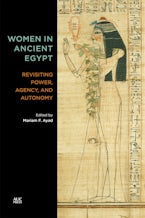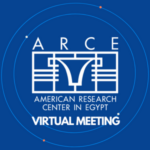- Home
- Women in Ancient Egypt

Women in Ancient Egypt
Revisiting Power, Agency, and Autonomy
Edited by Mariam F. Ayad
522 Pages, 6.00 x 9.00 in, 71 b&w illus. and 14 tables
- Hardback
- 9781649031808
- November 2022
- Region: Worldwide
$95.00
LE1300.00
£85.00
- EPUB
- 9781649032690
- November 2022
- Region: Worldwide
$94.99
- 9781649032706
- November 2022
- Region: Worldwide
$94.99
Where To Buy:
Cutting-edge research by twenty-four international scholars on female power, agency, health, and literacy in ancient Egypt
There has been considerable scholarship in the last fifty years on the role of ancient Egyptian women in society. With their ability to work outside the home, inherit and dispense of property, initiate divorce, testify in court, and serve in local government, Egyptian women exercised more legal rights and economic independence than their counterparts throughout antiquity. Yet, their agency and autonomy are often downplayed, undermined, or outright ignored. In Women in Ancient Egypt twenty-four international scholars offer a corrective to this view by presenting the latest cutting-edge research on women and gender in ancient Egypt.
Covering the entirety of Egyptian history, from earliest times to Late Antiquity, this volume commences with a thorough study of the earliest written evidence of Egyptian women, both royal and non-royal, before moving on to chapters that deal with various aspects of Egyptian queens, followed by studies on the legal status and economic roles of non-royal women and, finally, on women’s health and body adornment. Within this sweeping chronological range, each study is intensely focused on the evidence recovered from a particular site or a specific time-period. Rather than following a strictly chronological arrangement, the thematic organization of chapters enables readers to discern diachronic patterns of continuity and change within each group of women.
· Clémentine Audouit, Paul Valery University, Montpellier, France
· Anne Austin, University of Missouri, St. Louis, Missouri, USA
· Mariam F. Ayad, The American University in Cairo, Cairo, Egypt
· Romane Betbeze, Université de Genève, Switzerland, and Ecole Pratique des Hautes Etudes, PSL, France
· Anke Ilona Blöbaum, Saxon Academy of Sciences and Humanities in Leipzig, Leipzig, Germany
· Eva-Maria Engel, Humboldt-Universität zu Berlin, Berlin, Germany
· Renate Fellinger, University of Cambridge, Cambridge, UK
· Kathrin Gabler, University of Basel, Basel, Switzerland
· Rahel Glanzmann, independent scholar, Basel, Switzerland.
· Izold Guegan, Swansea University, UK, and Sorbonne University, Paris, France
· Fayza Haikal, The American University in Cairo, Cairo, Egypt
· Janet H. Johnson, Oriental Institute, University of Chicago, Chicago, Il, USA
· Katarzyna Kapiec, Institute of the Mediterranean and Oriental Cultures of the Polish Academy of Sciences, Warsaw, Poland
· Susan Anne Kelly, Macquarie University Sydney, Sydney, Australia
· AnneMarie Luijendijk, Princeton University, Princeton, New Jersey, USA
· Suzanne Onstine, University of Memphis, Memphis, Tennessee, USA
· José Ramón Pérez-Accino Picatoste, Facultad de Geografía e Historia, Universidad Complutense de Madrid, Madrid, Spain
· Tara Sewell-Lasater, University of Houston, Houston, Texas, USA
· Yasmin El Shazly, American Research Center in Egypt, Cairo, Egypt
· Reinert Skumsnes, Centre for Gender Research, University of Oslo, Oslo, Norway
· Isabel Stünkel, The Metropolitan Museum of Art, New York, New York, USA
· Inmaculada Vivas Sainz, National Distance Education University), Madrid, Spain
· Hana Vymazalová, Czech Institute of Egyptology, Faculty of Arts, Charles University, Prague, Czeck Republic
· Jacquelyn Williamson, George Mason University, Fairfax, Viriginia, USA
· Annik Wüthrich, Austrian Academy of Sciences, Austrian Archaeological Institute, Vienna, Austria
Illustrations
Contributors
Foreword: Women in Ancient Egypt: Current Research and Historical Trends
Fayza Haikal
1. Moving Beyond Gender Bias
Mariam F. Ayad
THE EARLIEST EVIDENCE
2. Early Dynastic Women: The Written Evidence
Eva-Maria Engel
ROYAL WOMEN: EXPRESSIONS OF POWER AND INFLUENCE
3. The Funerary Domains of Setibhor and Other Old Kingdom Queen
Hana Vymazalová
4. Elevated or Dimished? Questions Regarding Middle Kingdom Royal Women
Isabel Stünke
5. Egyptianizing Female Sphinxes in Anatolia and the Levant during the Middle Bronze Age
Yasmin El-Shazly
6. An Intriguing Feminine Figure in the Royal Cachette Wadi: New Findings from C2 Project
José Ramón Pérez-Accino Picatoste and Inmaculada Vivas Sainz
7. The Role of Amunet during the Reign of Hatshepsut
Katarzyna Kapiec
8. Power, Piety, and Gender in Context: Hatshepsut and Nefertiti
Jacquelyn Williamson
9. Arsino II and Berenike II: Ptolemaic Vangaurds of Queenly Political Power
Tara Sewell-Lasater
NONROYAL WOMEN: LEGAL AND ECONOMIC ASPECTS
10. Women in the Economic Domain: First to Sixth Dynasties
Susan Anne Kelly
11. Ostentation in Old Kingdom Female Tombs: Between Iconographic Conventions and Gendered Adaptations
Romane Betbeze
12. The hxnr.wt: A Reassessment of Their Religious Roles
Izold Guegan
13. Family Contracts in New Kingdom Egypt
Reinert Skumsnes
14. The Women of Deir al-Medina in the Ramesside Period: Current State of Research and Future Perspectives on the Community of Workers
Kathrin Gabler
15. Some remarks on the Shabti Corpus of Iyneferty
Rahel Glanzmann
16. Some Notes on the Question of the Feminine Identity at the Beginning of the Twenty-First Dynasty in the Funerary Literature
Annik Wüthrich
17. The Role and Status of Women in Elite Family Networks of Late Period Thebes: The Wives of Montuemhat
Anke Ilona Blöbaum
18. Women’s Participation as Contracting Parties and Ownership Rights as Recorded in Demotic Documents for Money from Ptolemaic Upper Egypt: A Case Study of Change?
Renate Fellinger
19. Women in Demotic (Documentary) Texts
Janet H. Johnson
20. Shoes, Sickness, and Sisters: The (In)visibility of Christian Women from Late Antique Oxyrhynchus
AnneMarie Luijendijk
THE FEMALE BODY
21. Women’s Intimacy: Blood, Milk, and Women’s Conditions in the Gynecological Papyri of Ancient Egypt
Clémentine Audouit
22. Women’s Health Issues as Seen in Theban Tomb 16
Suzanne Onstine, Jesús Herrerin López, Nataša Šarkić, Miguel Sanchez, and Rosa Dinarès Solá
23. Shifting Perceptions of Tattooed Women in Ancient Egypt
Anne Austin
List of Abbreviations
Bibliography
Mariam F. Ayad is an associate professor of Egyptology at the American University in Cairo. In 2020–2021 she was a visiting associate professor of Women’s Studies and Near Eastern Religions and a research associate of Harvard Divinity School’s Women’s Studies in Religion Program. She is the author of God’s Wife, God’s Servant: The God’s Wife of Amun (c. 740–525 BC), and the editor of three volumes on Coptic Culture, including Studies in Coptic Culture: Transmission and Interaction.
"Women in Ancient Egypt: Revisiting, Power, Agency, and Autonomy provides an indispensable collection of the freshest and most creative research on women in ancient Egypt from the dawn of the state to Late Antiquity, exploring the lives of women at various levels of society as well as ancient Egyptian perceptions of the female body. This volume aims to be a counter to previous studies which have downplayed, dismissed, or oversexualized the evidence of women in the archaeological record, and it hits the mark."—Kara Cooney, UCLA
“This book is the first comprehensive treatment of women in ancient Egypt in general, both royal and non-royal, from the Early Dynastic Period to Late Antiquity. The brilliant in-depth studies covering diverse sources—texts, pictures, and material culture—provide excellent insight into very different aspects of the lives of women, thus illuminating a broad thematic framework. The inclusion of considerations of power, economy, law, and health and the body is a welcome extension to the focus on the feminine world in ancient Egypt.”—Angelika Lohwasser, University of Münster, Germany
"If women are absent from the scholarship on ancient Egypt, it is not because they are absent from the sources. The stunning new research gathered here by Mariam Ayad demonstrates not only women’s presence, but their power, diversity, and importance. Egyptology takes a huge step forward with topics ranging from the authority of royal women to incantations to stop bleeding after miscarriage."—Ann Braude, Harvard Divinity School
"Superb. A range of fascinating, challenging papers. Highly recommended!"—Campbell Price, Manchester Museum, University of Manchester
"[A]bounds with many illustrations and tables and utilizes a dizzying array of evidence, including tomb art, marriage documents, family contracts, gynecological papyri, furniture legs, graffiti, and tattooed corpses. . . . Recommended. Advanced undergraduates through faculty."—CHOICE
Forthcoming Events

ARCE 2024 Virtual Annual Meeting
Friday. May 17, 2024 | 3:00 pm
via Web Platform. Detailed information about the platform and access information to the virtual component will be forthcoming.
Read more










